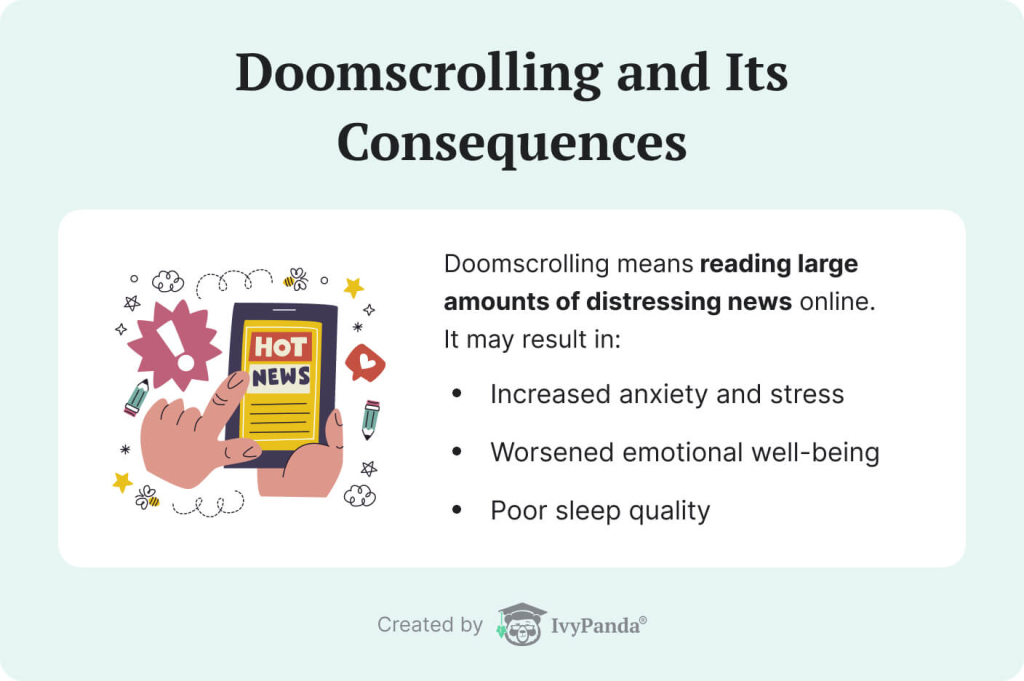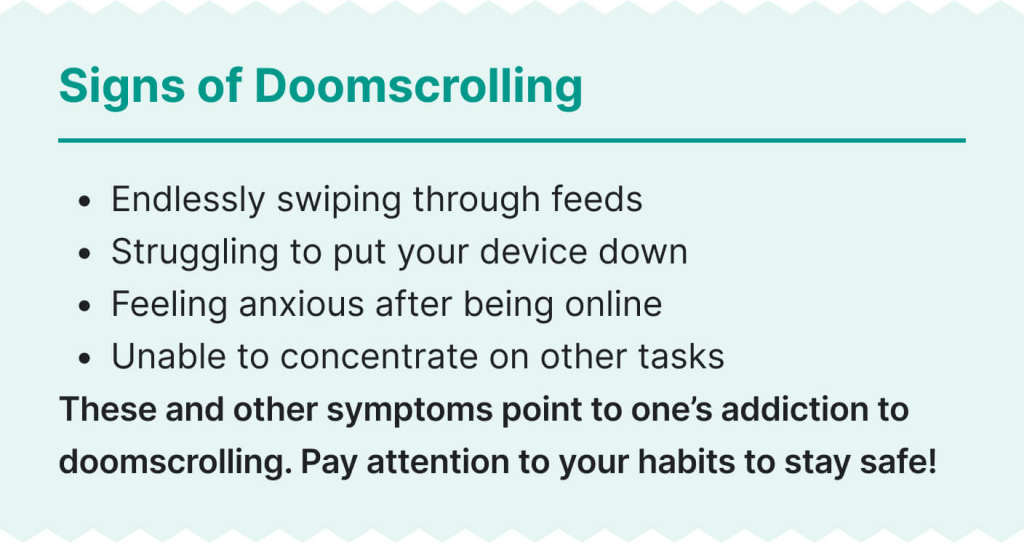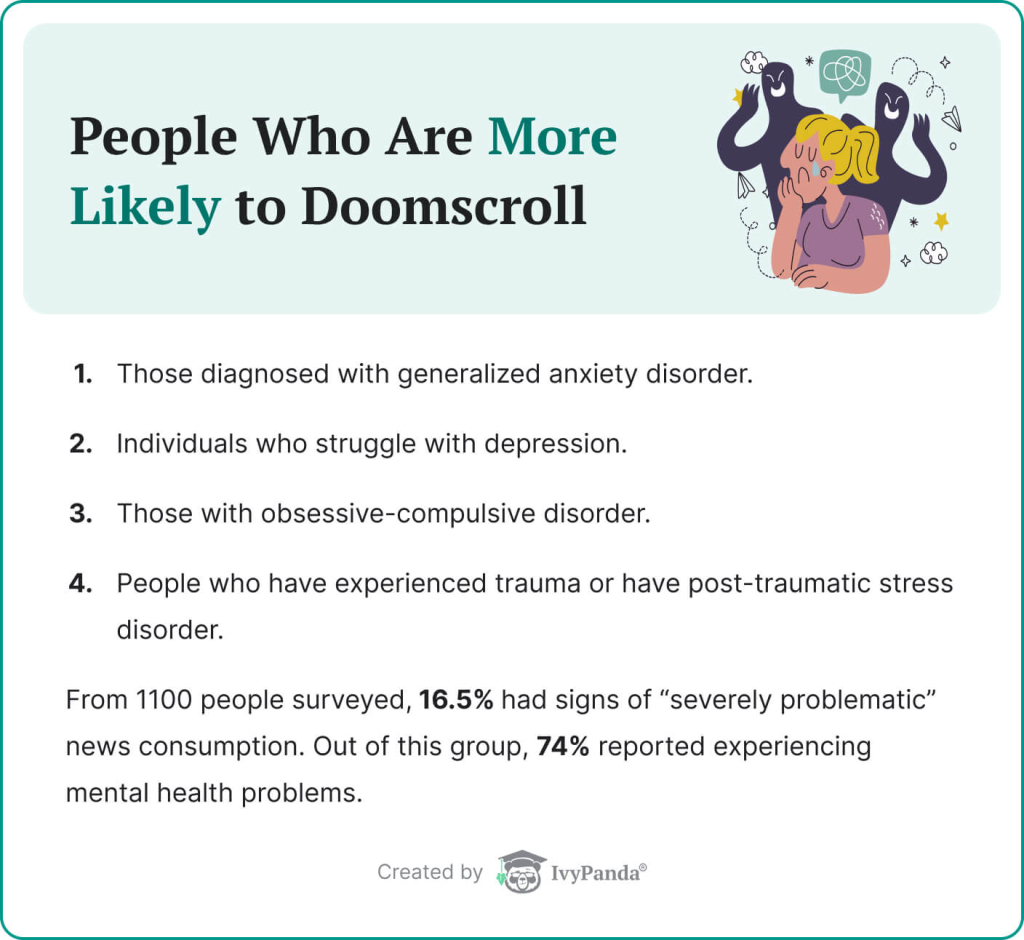Have you ever found yourself endlessly scrolling through the tragic news? If so, you’re not alone. This phenomenon, known as “doomscrolling” or “doomsurfing,” has become increasingly widespread today. We’ve all had those moments when we can’t get away from the screen, even though it leaves us feeling drained and agitated.

But why do we do it? Why can’t we withstand the pull of these devastating stories? And what are the effects of constantly consuming negative news?
In this article, we’ll explain the psychology behind doomscrolling and offer some tips for addressing it. Also, check out our essay database, where you can find thousands of free papers on the most acute topics.
📱 What Is Doomscrolling
The term “doomscrolling” gained popularity in early 2020 to describe a digital behavior that became more prevalent during the COVID-19 pandemic due to physical isolation. It was initially coined in 2018 and later popularized by journalist Karen Ho. This concept refers to continuously and obsessively scrolling through social media feeds, primarily focusing on distressing, depressing, or harmful content.
*Check out Karen Ho’s Doomscrolling Reminder Bot, which reminds you to take a break and stop doomscrolling.
Doomscrolling differs from regular scrolling in terms of its content and psychological impact. Scrolling typically involves navigating through various types of content, including news, entertainment, and social updates. Meanwhile, doomscrolling means getting trapped in a cycle of consuming alarming headlines, gloomy statistics, and disheartening stories. Unlike regular scrolling, which can be casual and pleasant, doomscrolling is more compulsive and emotionally draining. Thus, it leads to stress and a sense of helplessness.

10 Signs You Are Doomscrolling
Here are several signs that you are most probably doomscrolling:
- You endlessly swipe through feeds without realizing how much time has passed.
- Your primary attention is on harmful or alarming news, while you often disregard positive or neutral stories.
- You struggle to put your device down or can’t resist the urge to keep scrolling, even when it’s affecting your mood or productivity.
- You frequently feel anxious, overwhelmed, or upset after being online.
- It’s hard for you to fall or stay asleep.
- You can’t fully concentrate on other tasks and responsibilities.
- You can’t break the cycle of encountering more distressing information.
- You underestimate the time you spend scrolling, realizing later that it has eaten up a substantial portion of your day.
- You have frequent headaches, eye strain, or muscle tension from prolonged screen time.
- You prioritize scrolling through negative news over engaging in self-care activities or pursuing hobbies.
🧠 The Science Behind Doomscrolling
According to a survey published in Health Communication, approximately 16.5% of the 1,100 participants displayed signs of excessive problematic news consumption, contributing to higher stress levels, anxiety, and a negative impact on overall health. The question is, what mechanisms in our brain pull us into this vicious cycle?
Doomscrolling can be partly interpreted by our brain’s reward system. Once we receive novel and undesired information, it urges dopamine release, which is connected to pleasure and reward. Our brain gets programmed to get this reward, leading to a chain of seeking out and consuming more negative information, regardless it may be psychologically distressing.
Moreover, due to its evolutionary significance, our brain is wired to pay more attention to negative information. This negativity bias is a survival mechanism and helps us detect potential environmental threats and dangers. When something as big as the COVID-19 pandemic happens, we strive to consume as much information as possible because we think that the more we know, the safer we are. Although we begin this behavior as a deliberate action – trying to find information in a crisis – we get trapped in the loop of automatic and unintentional doomscrolling.
Who Is More Likely to Doomscroll
Studies demonstrate that individuals prone to anxiety, depression, or obsessive-compulsive behaviors are more likely to doomscroll. The following categories are at high risk of doomscrolling:
- Those diagnosed with generalized anxiety disorder frequently experience heightened anxiety levels. They tend to engage in doomscrolling to stay informed.
- Individuals who fight depression are drawn to doomscrolling as an instrument of self-validation or to reinforce pessimistic beliefs.
- Obsessive-compulsive disorder patients may exhibit compulsive behaviors, including a constant need to stay current with news.
- People who have gone through trauma or have post-traumatic stress disorder may practice doomscrolling to anticipate potential threats around them.

However, while these individuals may be more predisposed to doomsurfing, the habit can affect anyone, regardless of their condition. Doomscrolling is common among news and social media enthusiasts, highly stressed individuals, and empathetic persons who feel responsible for staying informed and connected.
⚡ How Doomscrolling Affects You
In today’s digital world, doomscrolling has become a prevalent habit. As we mindlessly browse negative news and information flows, the impact on our mental well-being cannot be disregarded. Let’s delve into how doomscrolling facilitates our health and other parts of our daily lives.
Impact on Mental Health
Doomscrolling can have various adverse consequences for our psychological health:
- Increased anxiety. Constantly consuming pessimistic news can contribute to heightened anxiety as our minds focus on worst-case scenarios and possible threats.
- Higher stress levels. Doomscrolling can trigger the boost of stress hormones, causing increased tension in our bodies and minds.
- Negative mood and emotional well-being. Continuous exposure to distressing news can make us feel down, overwhelmed, and hopeless, affecting our overall emotional state.
- Poor sleep quality. Doomscrolling, especially before bedtime, can worsen sleep patterns and result in insomnia.
- Impact on self-esteem. Comparing ourselves to the negative headlines and experiences of others can impact our self-esteem and contribute to feelings of inadequacy or helplessness.
- Triggering mental health conditions. For individuals already struggling with mental health conditions such as anxiety, depression, or trauma-related disorders, doomscrolling can strengthen symptoms and trigger episodes.
Impact on Other Aspects
In addition to its impact on mental health, doomscrolling can affect people in the following ways:
- Reduced productivity and motivation. Spending excessive time online can hinder productivity, diverting our attention from important tasks and goals.
- Time wastage. Engaging in doomscrolling can lead to significant time wastage, as hours pass unnoticed while scrolling through endless negative content.
- Physical health implications. Extended periods of sitting or lying down while scrolling through screens can contribute to a sedentary lifestyle, potentially leading to health issues like obesity, cardiovascular problems, and muscular imbalances.
- Relationship strain. Excessive doomscrolling can negatively impact relationships, as it takes away time and attention that could be dedicated to personal connections. One might also become overly irritated and release anger on their loved ones.
- Impaired focus and attention. Constant exposure to negative news and chaotic information through doomscrolling can impair our ability to focus and concentrate on essential tasks. This can result in reduced cognitive performance and difficulties in retaining information.
- Energy drain. Engaging in doomscrolling can leave individuals feeling emotionally drained and mentally exhausted. The constant exposure to distressing news can deplete their energy reserves and lead to emotional burnout.
📢 How to Stop Doomscrolling
Breaking the doomscrolling habit is a process that demands conscious effort and dedication. By implementing these tips, you can regain control over your digital habits and cultivate a healthier relationship with information consumption:
⏱️ Set specific time constraints. Set aside a limited amount of time for daily social media and news scrolling. Use apps like Moment and Space that remind you once your time limit is up.
📵 Establish tech-free zones. Create designated areas in your home or specific times throughout the day when electronic devices are off-limits. This can help decrease the temptation to start mindless scrolling.
🧘 Practice mindfulness. Be present and aware of your actions while using digital devices. Pay attention to how doomscrolling affects your mood and well-being, and consciously engage in more positive activities instead.
🔕 Disable notifications. Minimize distractions by turning off push notifications for social media and news apps. This reduces the urge to check for updates constantly and helps you regain control over your attention span.
📰 Choose trusted news sources. Be mindful of the information sources you follow and rely on. Select reputable, balanced news sources that comprehensively view current events rather than platforms that sensationalize negative news.
🤖 Out-think the algorithms. Avoid consuming negative news on social media, as it will lead to a cycle of similar stories being recommended. Instead, seek out positive news sources such as the Good News Network or follow accounts that share uplifting content.
📖 Engage in alternative activities. Find activities that bring you joy, relaxation, or fulfillment, such as hobbies, exercise, reading, spending time in nature, or connecting with loved ones. Fill your time with these activities instead of doomscrolling.
🔌 Practice digital detox. Consider taking periodic breaks from social media and news apps. Detox periods allow you to reset, recharge, and regain a healthier perspective on information consumption.
📐 Set boundaries. Establish specific rules for your digital consumption, for example, no phone usage during meals or dedicated breaks during the day without any devices.
🚀 Use productivity techniques. Employ productivity techniques like the Pomodoro Technique to structure your work or study time. Focusing on short bursts of concentrated work minimizes distractions and reduces the likelihood of doomscrolling.
🤲 Seek support. Share your intentions of reducing doomscrolling with friends or family members and encourage them to hold you accountable. Having a support system can provide guidance, understanding, and encouragement.
In today’s digital age, it’s easy to get dragged by negative news. Doomscrolling can have a major impact on our mental health and overall well-being. It can trigger depressive and anxious feelings and hopelessness. However, there are ways to combat this harmful habit and prioritize our mental health.
Remember that we can outsmart the algorithm and develop a healthier relationship with our digital devices. Implementing strategies to limit doomscrolling, finding alternative sources of information, and engaging in positive activities can contribute to a more balanced and fulfilling life.
🔗 References
- The Dark at the End of the Tunnel: Doomscrolling on Social Media Newsfeeds
- Doomscrolling: Impacts on Mental Health, How to Stop
- What Is Doomscrolling? And How to Give Your Thumb a Break
- Doomscrolling linked to poor physical and mental health, study finds | Mental health | The Guardian
- Doomscrolling: Definition, Effects, Mental Health
- What’s Doomscrolling and Can It Harm You?
- How to Stop Doomscrolling—With Psychology | WIRED



